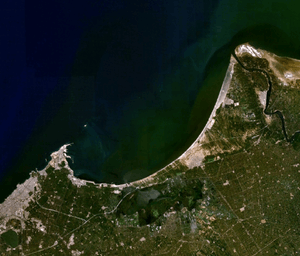Abu Qir Bay

The Abū Qīr Bay (sometimes transliterated Abukir Bay or Aboukir Bay) (Arabic: خليج أبو قير; transliterated: Khalīj Abū Qīr) is a spacious bay on the Mediterranean Sea in Egypt, lying between Abu Qir (near Alexandria) and the Rosetta mouth of the Nile. The ancient cities of Canopus, Heracleion and Menouthis lie submerged beneath the waters of the bay. In 1798 it was the site of the Battle of the Nile, a naval battle fought between the British Royal Navy and the Navy of the French First Republic. The bay contains a natural gas field, discovered in the 1970s.
Battle of the Nile

On August 1, 1798, Horatio Nelson fought the naval Battle of the Nile, often referred to as the "Battle of Aboukir Bay". (Not to be confused with the Battle of Abukir (1799) and the Battle of Abukir (1801).)
On 1 March 1801, some 70 British warships, together with transports carrying 16,000 troops, anchored in Aboukir Bay near Alexandria. The intent was to defeat the French expeditionary force that had remained in Egypt after Napoleon's return to France.
Bad weather delayed disembarkation by a week but, on 8 March, Captain Alexander Cochrane of HMS Ajax deployed 320 boats, in double line abreast, to bring the troops ashore. French shore batteries opposed the landing, but the British were able to drive them back and, by the next day, all of Sir Ralph Abercromby's British army was ashore. The British then defeated the French army at the Battle of Alexandria. The Siege of Alexandria followed, with the city falling on 2 September 1801.
Antiquities

The bay contains the underwater archaeological sites of three cities from the pre-Hellenistic, Hellenistic and Roman periods.[1] The Eastern part of ancient city of Canopus is submerged in the bay,[2] along with the remains of Menouthis[3] and its sister-city Herakleion–Thonis which now lies 7 kilometres offshore.[4] They were excavated by French underwater archaeologist Franck Goddio.
See also
References
- ↑ Mirsky, Steve (31 January 2010). "Cleopatra's Alexandria Treasures". Scientific American. Retrieved 23 July 2015.
- ↑ Rothstein, Edward (3 June 2010). "Cleopatra's Underwater Kingdom". The New York Times. Retrieved 23 July 2015.
- ↑ Shwartz, Mark (11 December 2000). "Scientists, archaeologists and historians will unravel the mystery of Egypt's sunken cities" (Press release). California: Stanford University. Retrieved 23 July 2015.
- ↑ "Lost underwater city explored in documentary". Νεος Κοσμος. 3 May 2013. Retrieved 23 July 2015.
Coordinates: 31°18′N 30°10′E / 31.300°N 30.167°E